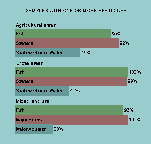
More than 90 percent of water and fish samples from all streams contained one or, more often, several pesticides. Pesticides found in water were primarily those that are currently used, whereas those found in fish and sediment are organochlorine insecticides, such as DDT, that were heavily used decades ago. Most of the pesticides in use today are more water soluble and break down faster in the natural environment than the long-lived organochlorine insecticides of the past. (31)
 |
| image size 5KB--gif |
About 50 percent of the wells sampled contained one or more pesticides, with the highest detection frequencies in shallow ground water beneath agricultural and urban areas and the lowest frequencies in major aquifers, which generally are deeper. Ground water has a lower incidence of pesticide contamination than streams because water infiltrating the land surface moves slowly through soil and rock formations on its way to ground water and through the aquifer. This contact with soil and rock and the slow rate of flow allow greater opportunity for sorption and degradation of pesticides, and varied flow pathways mean that some wells do not tap ground water that originated from places or times affected by pesticide use.
Although streams and rivers are more vulnerable than ground water to rapid and widespread contamination, ground-water contamination is extremely difficult to reverse because of the slow rate of ground-water flow.
Management practices that reduce the transport of pesticides to streams can yield rapid improvements in water quality. Ground water, on the other hand, will respond slowly to changing practices--sometimes taking many years or even decades to recover.
|
WHAT WAS MEASURED... Many of the Nation's most heavily used agricultural and urban pesticides were measured in the NAWQA Program. The 83 target compounds analyzed in water include 76 pesticides and 7 selected breakdown products and account for about 75 percent of the Nation-- agricultural use of synthetic pesticides. They include 17 of the top 20 herbicides and 15 of the top 20 insecticides. Historically used organochlorine insecticides, like DDT, were measured in bed sediment and fish, where they accumulate and persist for decades. The 32 organochlorine compounds analyzed in bed sediment or fish consist of 8 individual parent compounds, 1 individual breakdown product, and 7 groups of parent compounds plus related breakdown products or chemical impurities in the manufactured product. These compounds account for more than 90 percent of the Nation's historical use of organochlorine insecticides in agriculture. |
WHAT WAS NOT...
Many important pesticide compounds were not measured because of analytical and budget constraints. The top 20 herbicides not measured were glyphosate (ranked 10), MSMA (14), and propazine (17). The top 20 insecticides not measured were cryolite (12), acephate (13), dimethoate (14), methomyl (15), and thiodicarb (18). Other pesticides not measured include inorganic pesticides, such as sulfur and copper, oil, and biological pesticides. Important omissions also include numerous pesticide breakdown products and carrier agents that may affect water quality. Although NAWQA studies are targeting the broadest and most complete range of pesticides ever measured in a single assessment, these omissions are important to keep in mind and must temper conclusions. Further information on pesticides measured is available via the World Wide Web at . http://water.usgs.gov/lookup/get?nawqapest |
| Pesticides are a potential concern for human health and aquatic life | |
| Pesticides | |
| The Quality of Our Nation's Water--Nutrients and Pesticides |